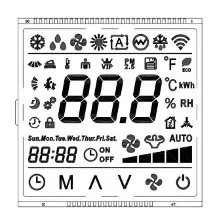Key Considerations When Replacing an HTN Segment Varitronix LCD Module
2025-03-13
HTN segment LCD modules are widely used in electronic devices for their reliability and low power consumption. However, like any component, these displays can wear out over time, requiring a replacement. While swapping out an LCD module might seem simple, there are several factors to consider to ensure compatibility and optimal performance.
This blog covers the most important considerations when replacing an HTN Segment Varitronix LCD Module to help you avoid common pitfalls.
1. Matching the New LCD Module with the Old One
Before purchasing a replacement module, confirm that it matches the specifications of the original Varitronix HTN segment LCD. Key factors to check include:
- Screen dimensions – Ensure the physical size matches the original display.
- Segment layout – The new module must have the same segment design as the original.
- Connector type – Check whether the display uses a flex ribbon cable, pin header, or soldered connection.
- Operating voltage – Verify that the voltage range is compatible with your device.
Mismatched specifications can result in improper functionality or even damage to the device’s circuit board.
2. Choosing Between OEM and Alternative Replacements
- OEM (Original Equipment Manufacturer) modules from Varitronix ensure full compatibility and performance.
- Third-party replacements may be more affordable but could require modifications to fit properly.
If an exact replacement is unavailable, an alternative module with the same electrical and mechanical specifications may work, but careful testing is necessary.
3. Proper Handling of the LCD Module
LCD modules are sensitive to static electricity, physical damage, and environmental conditions. When handling the replacement:
- Wear anti-static gloves to prevent electrostatic discharge (ESD) damage.
- Avoid bending the display or connectors during installation.
- Work in a clean and dry environment to prevent contamination or moisture damage.
4. Secure Mounting and Sealing
Some HTN segment LCD modules are mounted using:
- Adhesive backing – Used in many handheld devices.
- Screw mounts – Found in industrial equipment for added security.
- Snap-fit brackets – Used in appliances and automotive dashboards.
Ensuring the new module is securely mounted prevents vibration-related issues and misalignment.
5. Testing Before Final Assembly
Once the new module is installed:
- Power on the device and confirm that all segments display correctly.
- Check for flickering, missing segments, or incorrect readings.
- If issues arise, double-check connections and voltage levels using a multimeter.
Performing these tests before reassembling the device can save time and effort in troubleshooting later.
Replacing an HTN Segment Varitronix LCD Module requires careful attention to compatibility, installation, and testing. By following these guidelines, you can ensure a smooth replacement process and maintain optimal device performance.



